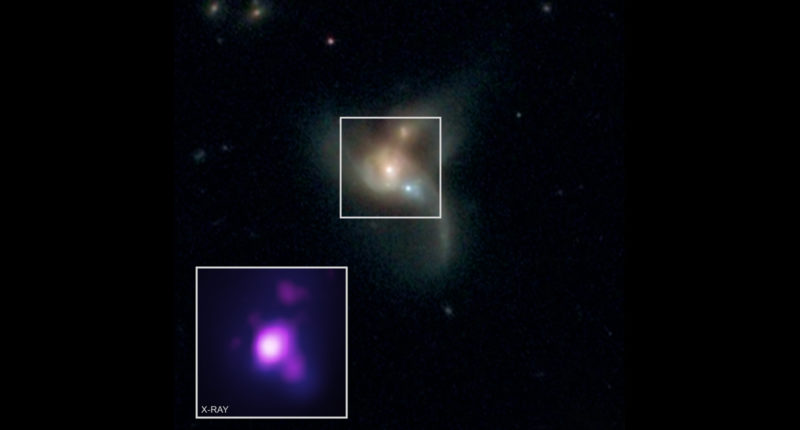A lot has been going on in “space” literally and lately. After Chandrayaan-2 Vikram’s unfortunate situation, Indians are already hyped about things happening in space.
Quite recently a stunning Nasa image has revealed three black holes smashing into each other in rare cataclysmic collision. According to scientists, the ultra-rare is the best evidence yet of a so-called “triple system” – three active supermassive black holes smashing in to each other. After NASA released its jaw-dropping images, space enthusiasts around the world are awe-struck.
Stephen Hawking had written a lot of research books and articles on black holes. Had he been alive, we’re pretty sure he would have developed something unimaginable to humans. Thereby discovering new horizons to the understanding of space.
“We were only looking for pairs of black holes at the time,” said Ryan Pfeifle, of George Mason University, who led the study.”And yet, through our selection technique, we stumbled upon this amazing system.”
Witnessing three black holes collide isn’t really a common thing and it surely takes sheer luck to notice this event. Two black holes colliding is a common phenomenon. Two NASA astronomers had observed this amazing feat of a “triple system” by “accident”.Eevery black hole is at the centre of its own galaxy and they’re all merging together roughly one billion light years from Earth.
Scientists didn’t straightaway click a picture of three Black Holes colliding, instead multiple observations were noted using several different scientific instruments were used to piece together this amazing incident. The system was first imaged in optical light by New Mexico’s Sloan Digital Sky Survey.
Pfeifle explained, “Through use of these major observatories, we have identified a new way of identifying triple supermassive black holes.”
“Each telescope gives us a different clue about what’s going on in these systems.We hope to extend our work to find more triples using the same technique.”
Nasa’s Wide-Field Infrared Survey Explorer spacecraft had already examined infrared light coming from the system by then. Following this researchers used X-ray observations to confirm the presence of gas and dust being consumed. Black Holes feeding is a living evidence that confirms they surely do exist.
Here are some principal facts about “Black Holes” (just in case you’re interested)
What is a black hole? ( A Balck Hole is not really black but “dark” )
- It is an inescapable region of space.
- Black holes have extremely strong gravitational effects, once you go in, there’s no way out.
- They’re called so because even light can’t escape once it’s been sucked in – which is why a black hole is completely dark.
Creation of black holes isn’t “magic”:
- Most black holes come into existence when a supergiant star dies.
- This happens when stars run out of fuel – like hydrogen – to burn, causing the star to collapse
- Following this, gravity pulls the centre of the star inwards quickly, and collapses into a tiny ball.
- It expands and contracts until one final collapse, causing part of the star to collapse inward thanks to gravity, and the rest of the star to explode outwards.
- What remains is a central ball is extremely dense, and if it’s especially dense, you get a black hole.
What is an event horizon?
- There must be a reason when you’re so close to a black hole but you can’t escape.
- Literally everything in the universe would have been sucked into one
- The point at which you can no longer escape from a black hole’s gravitational pull is called the event horizon. They vary depending on the Black Holes’ mass and size.
What is a singularity?
- The gravitational singularity is the very centre of a black hole
- It’s a one-dimensional point that contains an incredibly large mass in an infinitely small space
- At the singularity, space-time curves infinitely and the gravitational pull is infinitely strong
- Conventional laws of physics stop applying at this point.
According to NASA reports, each supermassive hole is roughly 10,000 to 30,000 light years apart, this is kind of “tiny” in real “space”. Their current location suggests that their eventual merging is inevitable –we can soon expect what scientists say a “cataclysmic” event that might transform the entire space.





